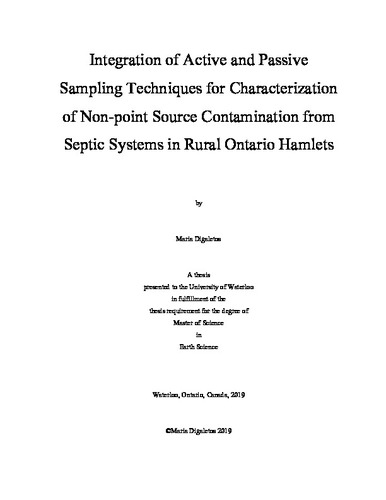| dc.description.abstract | Excessive nutrient loading to surface water bodies can lead to the development of eutrophic conditions, including deterioration of water quality and ecological stability. Sources of nutrient loading include wastewater treatment plants, agricultural activities, and to a lesser extent, septic systems. Septic systems are commonly used to dispose of domestic waste in rural areas where access to a municipal wastewater treatment system is not practical. When homes are closely spaced in rural communities forming hamlets, there are increased risks of nutrient impacts. Direct assessment of anthropogenically-derived nutrient loading from septic systems can involve costly and time-consuming investigations of subsurface releases. There is a need for indirect assessment of septic system releases through measurement of wastewater indicators within surface receiving waters. This thesis describes two studies on characterizing nutrient and contaminant concentrations in rural headwater streams: (1) a study sampling the upstream (US) and downstream (DS) locations of streams flowing through three rural hamlets for nutrients and organic tracers; and (2) the application of passive sampling techniques to determine time weighted average concentrations of an organic anthropogenic wastewater tracer and dissolved phosphorus.
Several anthropogenic tracers were used to delineate septic system discharge in rural hamlets. The selected suite included an artificial sweetener acesulfame-K (ACE-K), pharmaceuticals caffeine (CAF), carbamazepine (CBZ), gemfibrozil (GEM), ibuprofen (IBU), naproxen (NAP), and sulfamethoxazole (SMX), and a human specific biological indicator Bacteroides (BacHum) to determine wastewater impacts on the streams. Additional water quality parameters and nutrient concentrations were also measured, including soluble reactive phosphorus (SRP) and total ammonia and ammonium nitrogen (NH3+4-N). Three rural hamlets in the Grand River Watershed (Ontario) were selected for this study based on varying characteristics including home density and location relative to streams, stream geometry, and overburden material. The US and DS locations for each hamlet were sampled up to two times monthly between April 2017 and March 2018. Results indicate that non-point source contamination by septic systems is present in these areas, with downstream locations showing elevated concentrations of anthropogenic tracers. The tracers with the most elevated concentrations consistently across all three sites were ACE-K concentrations (~54 µg/L) and BacHum abundances (~107 counts/100 mL). The Spearman Rank Order Sum test significant (P < 0.05) results indicate that tracer concentrations are increasing along the streams. Elevated nutrient concentrations were also observed, including SRP concentrations up to 1.72 mg/L and NH3+4-N concentrations up to 5.51 mg/L. These results suggest that in densely populated rural areas near streams, elevated nutrient concentrations may be derived from septic systems. The nutrient-organic tracer correlation results were frequently insignificant or were not very strong, which indicates that it is difficult to quantify the extent of nutrient contamination by wastewater based on the nutrient and organic tracer concentrations.
Passive sampling techniques were applied to these headwater streams during two-week deployments in the spring, summer, and fall, followed by an intensive two-week study at one site. The polar organic chemical integrative sampler (POCIS) was used to target ACE-K, and a modified peeper filled with Fe-coated sand (P-Trap) was used to accumulate dissolved phosphorus. The samplers include two membranes secured around a receiving phase placed parallel to flow in the surface waters. Both samplers are designed to linearly uptake the contaminants and provide time weight average (TWA) concentrations which can be compared to average grab sample concentrations. The POCIS extract TWA concentrations of ACE-K (<2 ng/L to 11 ng/L) were up to three orders of magnitude lower than the mean grab sample concentrations (<140 ng/L to 2.7 µg/L). The results indicate that the POCIS utilized are not ideal for targeting ACE-K in surface waters. Issues with accumulation of debris and biofouling were observed on the POCIS and P-Traps upon collection, which may have hindered the interaction between the water and the membranes. The 14-day P-Trap TWA concentrations of dissolved P (US = 29.4 µg/L, DS = 45.5 µg/L) more closely approximated the mean grab sample concentrations (US = 27.1 µg/L, DS = 31.4 µg/L) compared to the 8-day results (TWA: US = 40.2 µg/L, DS = 53.6 µg/L; mean grab: US = 22.9 µg/L, DS = 26.0 µg/L) . Overall, the P-Trap performed better in the rural streams compared to the POCIS.
The results of this thesis suggest that headwater streams flowing within rural hamlets warrant increased attention to help mitigate nutrient loading and implement strategies to reduce septic system impacts. The use of a conservative tracer, like ACE-K, and a fecal indicator that is host specific, like Bacteroides, is recommended for future studies monitoring surface waters in rural areas. The use of passive sampling techniques shows potential as an environmental monitoring method in shallow streams, but requires selection of an appropriate phase, and actions are taken to minimize fouling. | en |

